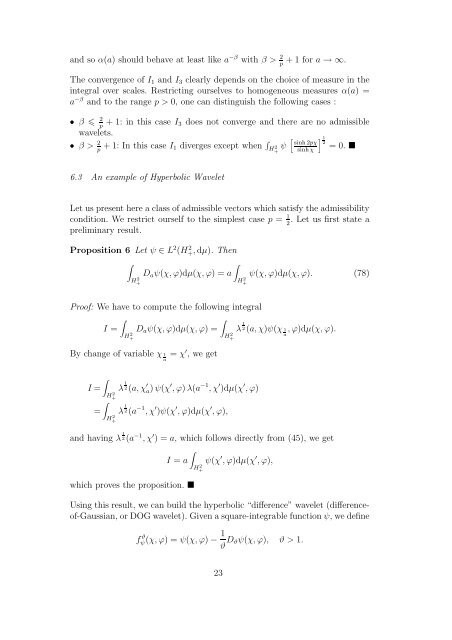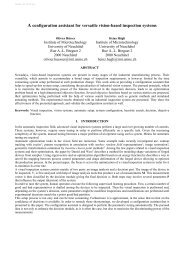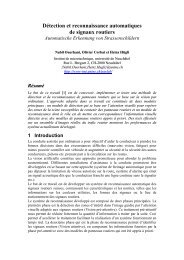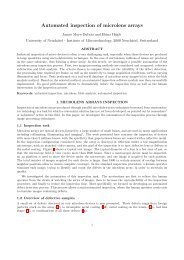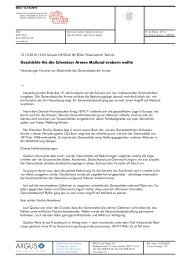Continuous Wavelet Transform on the Hyperboloid - Université de ...
Continuous Wavelet Transform on the Hyperboloid - Université de ...
Continuous Wavelet Transform on the Hyperboloid - Université de ...
You also want an ePaper? Increase the reach of your titles
YUMPU automatically turns print PDFs into web optimized ePapers that Google loves.
and so α(a) should behave at least like a −β with β> 2 +1fora →∞.<br />
p<br />
The c<strong>on</strong>vergence of I 1 and I 3 clearly <strong>de</strong>pends <strong>on</strong> <strong>the</strong> choice of measure in <strong>the</strong><br />
integral over scales. Restricting ourselves to homogeneous measures α(a) =<br />
a −β and to <strong>the</strong> range p>0, <strong>on</strong>e can distinguish <strong>the</strong> following cases :<br />
• β 2 +1: in thiscaseI p 3 does not c<strong>on</strong>verge and <strong>the</strong>re are no admissible<br />
wavelets.<br />
• β> 2 +1:InthiscaseI p 1 diverges except when ∫ H ψ [ ] 1<br />
sinh 2pχ 2<br />
=0.<br />
+ 2 sinh χ<br />
6.3 An example of Hyperbolic <str<strong>on</strong>g>Wavelet</str<strong>on</strong>g><br />
Let us present here a class of admissible vectors which satisfy <strong>the</strong> admissibility<br />
c<strong>on</strong>diti<strong>on</strong>. We restrict ourself to <strong>the</strong> simplest case p = 1 . Let us first state a<br />
2<br />
preliminary result.<br />
Propositi<strong>on</strong> 6 Let ψ ∈ L 2 (H+ 2 , dµ). Then<br />
∫<br />
∫<br />
D a ψ(χ, ϕ)dµ(χ, ϕ) =a ψ(χ, ϕ)dµ(χ, ϕ). (78)<br />
H+<br />
2 H+<br />
2<br />
Proof: We have to compute <strong>the</strong> following integral<br />
∫<br />
∫<br />
I = D a ψ(χ, ϕ)dµ(χ, ϕ) = λ 1 2 (a, χ)ψ(χ 1 ,ϕ)dµ(χ, ϕ).<br />
H+ 2 a<br />
H 2 +<br />
By change of variable χ 1<br />
a<br />
∫<br />
I =<br />
∫<br />
=<br />
H 2 +<br />
H 2 +<br />
= χ ′ ,weget<br />
λ 1 2 (a, χ<br />
′<br />
a ) ψ(χ ′ ,ϕ) λ(a −1 ,χ ′ )dµ(χ ′ ,ϕ)<br />
λ 1 2 (a −1 ,χ ′ )ψ(χ ′ ,ϕ)dµ(χ ′ ,ϕ),<br />
and having λ 1 2 (a −1 ,χ ′ )=a, which follows directly from (45), we get<br />
∫<br />
I = a ψ(χ ′ ,ϕ)dµ(χ ′ ,ϕ),<br />
H+<br />
2<br />
which proves <strong>the</strong> propositi<strong>on</strong>. <br />
Using this result, we can build <strong>the</strong> hyperbolic “difference” wavelet (differenceof-Gaussian,<br />
or DOG wavelet). Given a square-integrable functi<strong>on</strong> ψ, we <strong>de</strong>fine<br />
f ϑ ψ(χ, ϕ) =ψ(χ, ϕ) − 1 ϑ D ϑψ(χ, ϕ), ϑ > 1.<br />
23


